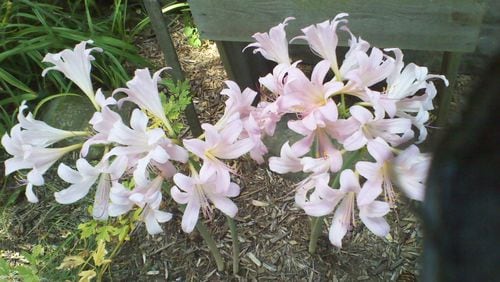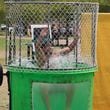Q: I thought I planted Belladonna amaryllis bulbs (some people call them Naked Ladies) near some other amaryllis in my garden, but the leaves don’t look like amaryllis. My unidentified clump has strap-like leaves with rounded tips coming from one spot in the ground. Becky Hembree, Calhoun
A: I think you have Lycoris squamigera, a different bulb also known as Naked Ladies, behaving normally. Both plants’ leaves emerge in early spring to early summer and they disappear by June. The flowers pop up from the buried bulbs in August or September. In botany, the pattern of flowering before the leaves appear is known as hysteranthous. Both Lycoris and Amaryllis are commonly called Naked Ladies, but they are completely different plants. Amaryllis belladonna is not common in North Georgia because it is often damaged by cold weather. The Lycoris is much more hardy. Also, it never produces seeds after the flower fades. Now comes a special shout-out to Mrs. Inez Hames, who taught me high school Latin. I am forever grateful for her efforts!
Q: I see a lot of online ads for metal raised beds. These supposedly last up to 20 years and are food safe. In nine years at my current home, I have had to replace my treated wood beds due to termites and rot, and they need to be replaced again. I am 70 and I want something that I won’t have to replace until I am 90. Kathy Standefer, Lincoln County
A: I have seen edible gardens grown in galvanized cattle watering troughs. They looked great, but galvanized steel contains zinc and cadmium, which can be dangerous at high levels. The safety of using galvanized tubs for edible plants hasn’t been thoroughly researched. If you are concerned about harmful substances coming from the metal, you can line the inside of the container with plastic sheeting.
Q: Is creeping Jenny a good option for a ground cover around Knock Out roses, Drift roses and azaleas? The roses are in sun and the azalea bushes are in mostly shade. What would be the best ground cover? Sheryl Mayhue, email
A: Creeping Jenny (Lysimachia nummularia ‘Aurea’) is certainly a good candidate. It occasionally gets leaf spot and it dislikes clay soil, but otherwise, it is a good ground cover. You might look at Green & Gold (Chrysogonum virginianum), ajuga (Ajuga reptans), coral bells (Heuchera americana) and blue star creeper (Isotoma fluviatilis) as well. It’s hard for me to predict how well they would do in varying amounts of sun and shade, but all are tough and usually problem-free.
Email Walter at georgiagardener@yahoo.com. Listen to his occasional garden comments on “Green and Growing with Ashley Frasca” Saturday mornings on 95.5 WSB. Visit his website, walterreeves.com, or join his Facebook page at bit.ly/georgiagardener for his latest tips.






